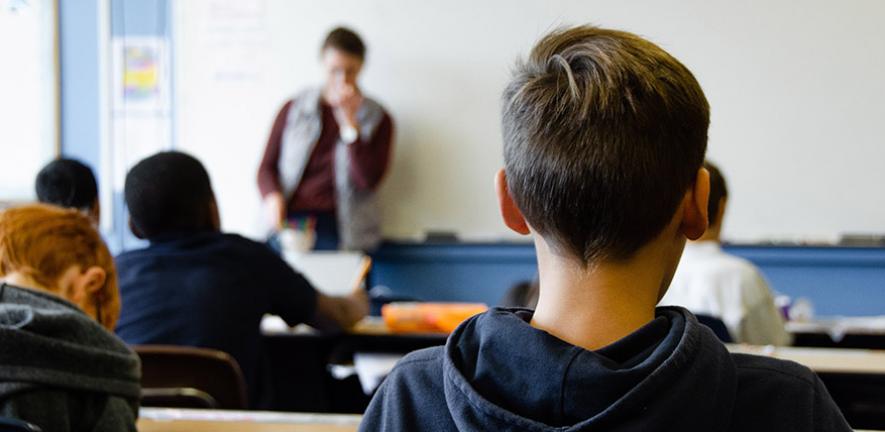
Newly-arrived pupils who speak English as an additional language (EAL) often make ‘mixed’ linguistic and academic progress during their first years in British schools, which need a proper framework to give them sustained support, a study suggests.
Newly-arrived pupils who speak English as an additional language (EAL) often make ‘mixed’ linguistic and academic progress during their first years in British schools, which need a proper framework to give them sustained support, a study suggests.
At the moment, it is often left to individual teachers or schools to decide how to handle the challenges of a multilingual classroom.
Karen Forbes
The finding is one of numerous results and recommendations in a new book about the language development of EAL pupils, and its impact on their attainment and social integration. The book, authored by a team of academics from Cambridge, Anglia Ruskin and Durham Universities, examines the complex relationship between language, education and the social integration of newcomer migrant EAL students.
According to the School Census, there are currently over 1.5 million EAL pupils in England, and the proportion is steadily rising. The trend is similar in many other English-speaking countries.
The book builds on three years of research involving over 40 schools across the East of England, funded by the Bell Foundation, and highlights much good practice by teachers working in multilingual classrooms. But it also points to inconsistencies and gaps in support for EAL pupils, stemming from an absence of national guidelines, targeted assessment, and systemic problems in areas such as teacher training and school-parent communication.
EAL pupils themselves were found to make uneven progress during their first two years in English schools. While many became competent English-speakers, their written English frequently lagged behind. The authors suggest this pattern may be further exacerbated by reductions in funding for EAL support.
As well as analysing the progress of EAL pupils, the study proposes a model for a more inclusive approach to teaching EAL students.
Dr Karen Forbes, Lecturer at the Faculty of Education, University of Cambridge, said: “At the moment, it is often left to individual teachers or schools to decide how to handle the challenges of a multilingual classroom. While many do excellent work, EAL pupils inevitably have a variable experience. Teachers and schools should be able to draw on a structured framework and a proper knowledge base so that they can give these pupils the sustained linguistic and educational support they often need.”
The research suggests that while many schools rightly prioritise the integration of EAL learners into mainstream lessons, some will need ongoing, one-to-one support, especially with developing more academic English, long past the point where they appear socially-integrated and able to hold a casual conversation.
This is just one symptom of a wider need to provide schools with a structural basis to give EAL learners individualised, ‘child-centred’ support, the authors argue. They stress that the ‘EAL’ label does not describe one type of pupil, but encompasses a wide range of previous educational experiences, interests and skills.
Encouragingly, many of the schools surveyed actively encouraged an inclusive and positive environment for EAL pupils. Teachers also employed various tactics that could form part of a wider framework to support them, such as group learning and buddy systems, translated texts and different visual aids.
But the study finds that many such interventions are devised locally, by schools or individual teachers, absent more structured or systematic guidance. This can lead to inconsistencies: for example, teachers varied their approach to when EAL pupils could use their home language, which often left students confused about when to use English.
The researchers argue that other mechanisms are needed to give teachers a more solid foundation for working with EAL pupils. Teachers consistently enthused, for example, about the ‘vital’ support provided by dedicated EAL co-ordinators and bilingual support staff. But many schools that the researchers surveyed have struggled to sustain such services given that funding is no longer ring-fenced for this purpose.
The book also highlights the need for more EAL-specific, specialist training for teachers, both for their professional practice and to help them work successfully with local minority-ethnic and migrant communities, especially those unfamiliar with the English system of education. This is only covered briefly in most teacher-training courses, and rarely forms part of their continuing professional development or ‘on the job’ learning.
Critically, the researchers also suggest that parents of EAL pupils and their communities are an untapped resource of knowledge, strong educational values and expertise.
The researchers found that many parents of EAL children have a high level of interest in their children’s education, but often are not sufficiently supported to understand context-specific curriculum choices, modes of assessment or school expectations. They argue that, as well as providing translated information and induction materials, schools should establish mechanisms such as EAL parents’ networks, empowering parents within school governance structures to inform the way that they support migrant pupils, ensure that they achieve their potential, and promote positive experiences in school.
“Overall, there is a need for a more systematic, whole-school approach to the education of EAL pupils,” Michael Evans, Emeritus Read in Second Language Education at the University of Cambridge, said. “This includes supporting teachers to develop their skills, providing them with a knowledge base on which to draw, and developing an effective communication system to promote parental engagement in schools. If that can be achieved, the benefits will be felt far beyond schools and EAL pupils alone.”
Language Development and Social Integration of Students with English as an Additional Language is published by Cambridge University Press on 16 July.

The text in this work is licensed under a Creative Commons Attribution 4.0 International License. Images, including our videos, are Copyright ©University of Cambridge and licensors/contributors as identified. All rights reserved. We make our image and video content available in a number of ways – as here, on our main website under its Terms and conditions, and on a range of channels including social media that permit your use and sharing of our content under their respective Terms.




